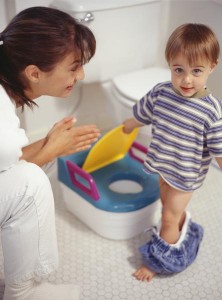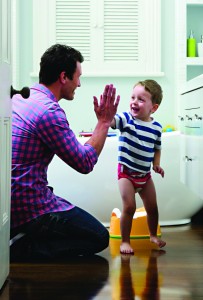Toilet training your child is a big step in them becoming more independent from your care, and it can seem daunting on where to start!
Preparation:
- On average a child will be around 2 years old when they are ready to start learning toilet training.
- A solid routine must be established with your child. E.g. Bed time, dinner time, and play time should occur the same times daily. This is to ensure it can be introduced at ease with your toddler.
- Your child should be walking and able to sit down for short durations.
- Shows discomfort in wearing nappies – pulls them off (or attempts too) when soiled or damp.
- If your child has good bladder control (if they have dry nappies after a few hours).
- Your child is able to pull his/her pants up and down.
- If your child is able to communicate (verbally or showing signs).
- Observing you or your partner going to toilet and taking an interest.
Where to start with teaching toilet training:
Start by introducing the potty to your child, and let them get familiar with it by touching, sitting and playing on it; and explain to them it’s where ‘wee wee’ and ‘poo poo’ goes (or any other language you may use to refer), and it’s also a lot more effective if you let them watch you and your partner go to the toilet. It may feel awkward, but let them watch and explain to them what you are doing; and they’ll soon follow by example.
Benchmark regular bowel movements:
You should notice particular times your toddler may need to go to the toilet e.g. some may go first thing in the morning. When it gets to that particular time, seat your toddler onto the potty, and if they do it correctly reward him/her with lots of praise!
Tip: It’s easy to tell a toddler when they are going wrong, but never forget the praise when they do it right!! This will encourage them to do it again for the happiness and attention.
The first day of toddler toilet training
- Your start date should be made easy as possible, and preferably when you are not going out.
- During day time cease using nappies, and instead dress your child in pants and loose easy to get off clothes. If the weathers warm then leave them in just underpants.
- Always place them on the potty for five minutes in moments they are most likely needing to go to the toilet. (not for long periods otherwise the child will associate the experience with a negative e.g. staying in time out.
- Ensure your child eats plenty of fibre and water to minimize chances of constipation.
- Always assert positive encouragement, and give praise where due (be patient if they are slow learning).
- Stay positive and keep trying; the child will be just as aggravated at not doing it right as you will be, so don’t exacerbate things by getting frustrated with them.
Good luck with switching your child over, and never be afraid of asking advise from other parents, or seeking more information from books or the internet; as every parent has been through this experience. It’s also key to remember that each child is an individual and what works for one toddler might not for the other – so always be open to trying new ideas!

